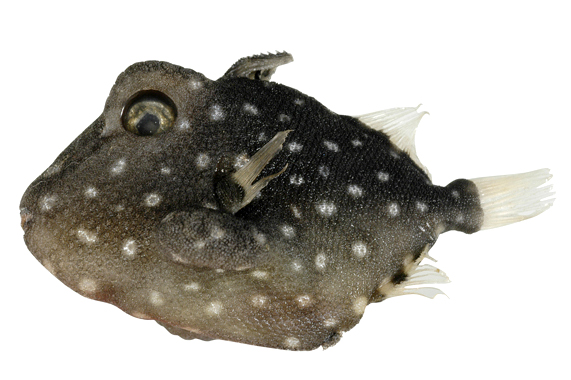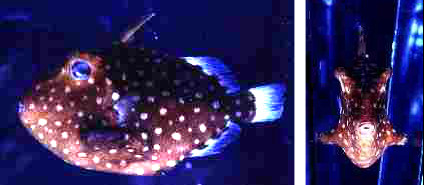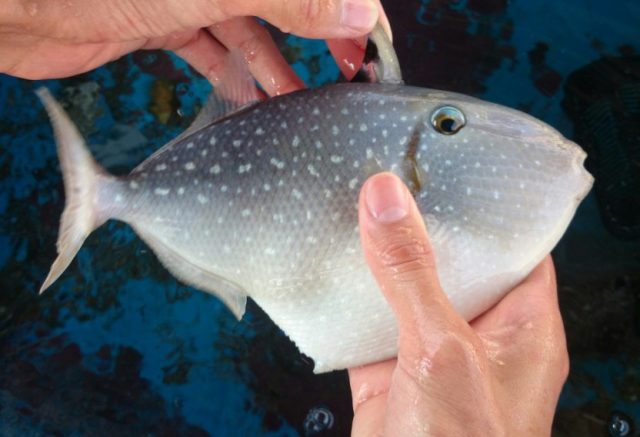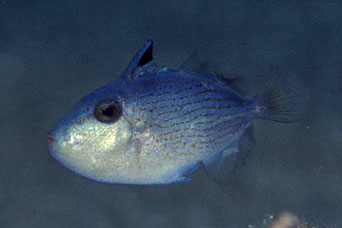
Xenobalistes punctatus? Credit: Australian National Fish Collection, CSIRO
Easily the most obscure and enigmatic members of the triggerfish family are the miniscule, misshapen creatures classified in the genus Xenobalistes. The first specimen ever found was from the stomach contents of a marlin collected in the Mariana Islands. When it was eventually described in 1981, it became the first new genus of triggerfish to be discovered in nearly 150 years, emphasizing just how unusual this find was. In fact, the author was so perplexed by Xenobalistes that he hypothesized that it likely represented the sister group to all other balistids; however, since then, evidence has been quickly mounting that suggests this fish is not what it seems.

A 39.1mm X. tumidipectoris, collected at 200-300 meters near Okinawa. Credit: Matsuura & Toda 2012
Xenobalistes can be loosely translated as meaning “strange triggerfish”, which is an apt name given its many peculiarities. Most noticeable is the oblong bony protuberance found beneath the pectoral fin (and alluded to in the species epithet tumidipectoris, meaning “fat pectoral”) and the highly sculptured ridge present above the eye, which calls to my mind the rugged appearance of a tyrannosaur skull. Also remarkable was the small size of the holotype specimen, measuring in at just 60 millimeters—positively puny by balistid standards. A second species, X. punctatus, would be found just two short years later washed up on a South African beach. The only specimen measured 96 millimeters and differed in having an extra pectoral fin ray, an additional scale row along the body, as well as rougher scales and a spinier dorsal fin. Even more obvious, it sported a starkly different color pattern of small white spots on a dark background.

Holotype specimen of X. punctatus. Credit: Phil Heemstra
Since their description more than three decades ago, there has been precious little information published on this genus, which raises the obvious question of why these little triggerfishes are so uncommon relative to nearly every other balistid. As it turns out, they’ve been hiding in plain sight and can even be found in the aquarium trade. I’ll let Dr. Phil Heemstra, who described X. punctatus, tell the story…

Subadult Xanthichthys caeruleolineatus, illustrating the late retention of the juvenile coloration. Credit: Toshimitsu
“…a moribund juvenile was picked up on the beach at Maitland [South Africa] by Arnold Slabbert of the Cape Nature Conservation Department. Fortunately, Mr Slabbert gave the struggling triggerfish to Roger and Richard Matlock, who resuscitated the little fish and nurtured it for four years, by which time the bony swellings below the pectorals were much reduced, and the fish had transformed into the beautiful colours of an adult bluelined triggerfish, Xanthichthys caeruleolineatus.”
That explains one species, but what of the other? The answer to X. tumidipectoris has only come to light with the help of some recent genetic research. An entire mitochondrial genome for this species was published in 2008 (from a specimen acquired by a Japanese research vessel), but, since these authors failed to include any Xanthichthys in their phylogenetic analysis, there was little that could be determined. The more thorough treatment by Santini et al 2013 took things a step further, using this same data, along with sequences from four species of Xanthichthys, to show that X. tumidipectoris clearly belonged within that genus and argued that Xenobalistes should be synonymized.
However, what these authors didn’t mention was the obvious conclusion that X. tumidipectoris is really nothing more than the juvenile of the Line Spot Triggerfish Xanthichthys lineopunctatus. The phylogenetic trees shown here use the same data (CO1 & 12S rRNA, available on GenBank) to confirm that the two are identical. What’s particularly interesting about this is that numerous images of settled juvenile X. lineopunctatus are documented and these show little similarity in coloration to “tumidipectoris”. On the other hand, the distinctive spotting of the juvenile X. caeruleolineatus (=punctatus) lasts until quite late in their development, as seen in the photo to the right.

This recently settled juvenile of X. lineopunctatus, looks very little like “tumidipectoris“. Credit: Kenji Nin
Why these two species show such differing developmental changes is one of the ocean’s many mysteries. One could also ask why juvenile Xanthichthys have such a bizarre morphology—of what benefit are the pectoral protuberances and the ridged head? With the handful of species in this genus being associated with the open waters around oceanic islands, it could be that this strange morphology is hydrodynamically advantageous for their pelagic larvae as they drift about the open ocean, but this isn’t an entirely convincing argument given that other balistids drift about in the same way. It would seem that, while we may have solved one question regarding “Xenobalistes”, many more remain.










0 Comments